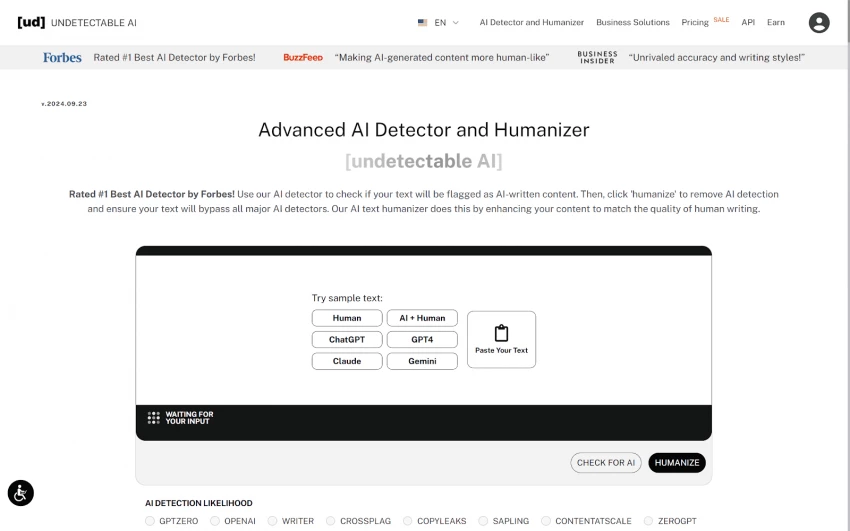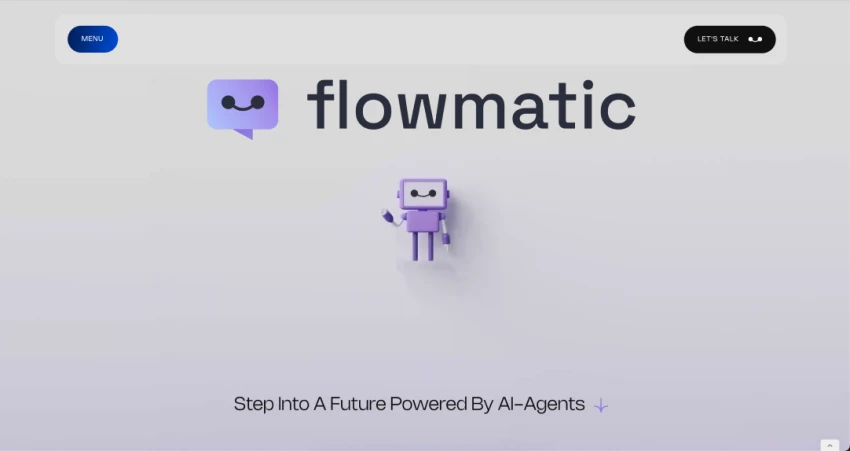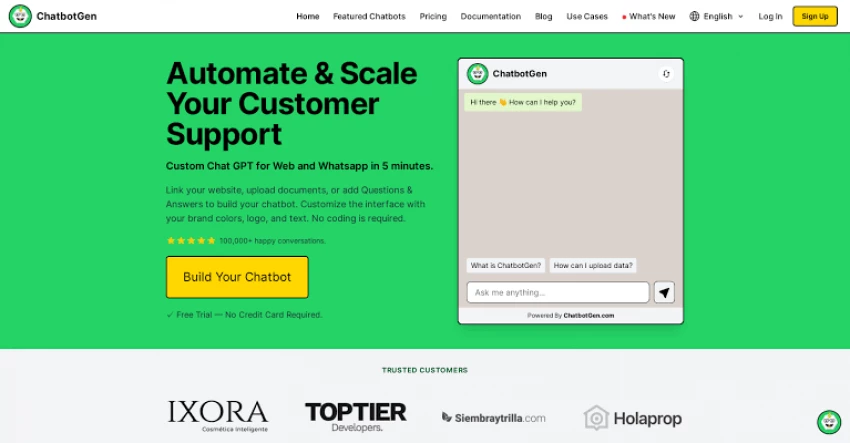AI continues to surge forward, but the most exciting breakthroughs often come from under-the-radar tools. These “hidden gems” can deliver niche capabilities, cost advantages, or fresh workflows not yet saturated in the market. This article profiles 10 AI tools you probably haven’t heard of (yet), and walks you through how to pick among them and get real value.
Tool Overview
Undetectable.ai offers AI content detection and obfuscation—it can analyze whether text is AI-generated and then transform it to evade detection.
Key Features
Text analysis for AI generation detection Obfuscation/rewriting to “humanize” AI text API for integration into content pipelines Real-time processing via web interface Pros & Cons
Pros
Helps content creators evade AI-detection flags (for e.g. academic checks) API support for bulk workflows Rapid performance Unique niche: many tools detect AI; fewer try to obfuscate Cons
Ethical, academic, or policy risks in obfuscating content Quality sometimes degrades readability Users report occasional “overcorrection” (rewrites that change meaning) Pricing can be steep for high volume Pricing
Undetectable.ai uses a usage-based model (per token / per word). Exact tiers are not publicly disclosed in detail; you must request a quote or use trial credits. Customer Reviews & Ratings
News and tech press have discussed Undetectable.ai as challenging content-detector systems. Some online testers report that it successfully lowers AI-detection scoresBut there is skepticism: some reviewers claim it doesn’t always maintain content fidelity Best For / Use Case
Content marketers, SEOs, or writers who want to publish AI-generated content without flagging Academic authors (though using it may conflict with institutional policies) Workflows needing bulk rewriting to pass AI detectors Tool Overview
JustDone is a web tool that detects whether a text was generated by AI, checks for similarity/plagiarism, and offers content validation.
Key Features
AI authorship verification (detects AI-generated segments)
Plagiarism/similarity check
Linguistic pattern analysis to spot LLM-origin content
Web-based interface for uploads or text input
Pros & Cons
Pros:
Multi-purpose: detection + plagiarism Useful for educators, editors, and content platforms Straightforward UI Cons:
Accuracy can vary false positives and false negatives reported. Limited free quota. Less mature than big-brand detectors No large public reviews available Pricing
JustDone follows a freemium + paid plan model. Exact prices are not broadly published; users often must upgrade for bulk checking features. Customer Reviews & Ratings
Being relatively new, it has a limited presence on major review sites Some user feedback (e.g. blog posts) praises its detection accuracy for short documents Other users caution that the tool can misclassify heavily edited or hybrid texts Best For / Use Case
Educators or editors vetting submitted contentSmall publishers or freelance editors Writers who want to self-audi t before submissionTool Overview
Fawkes is facial image-cloaking software: it subtly alters photos so that facial recognition models fail to match them.
Key Features
Cloaking transforms images at pixel level while retaining human viewability Batch processing for many images Standalone executable, works offline Open access / free in many versions Pros & Cons
Pros:
Protects privacy by defeating facial recognition matching Works locally (no need to upload images) Free / open access for many versions Useful for sensitive visual data Cons:
May degrade image quality slightly Some recognition systems eventually adapt Not suitable for identity verification systems Limited support or updates Pricing
Most releases of Fawkes are free or open-source.
Customer Reviews & Ratings
Widely cited in privacy and security communities Popular among activists, privacy advocates Some users note that it works against older recognition models; efficacy against newer systems is less certain Best For / Use Case
Journalists, activists , or privacy-centric individuals who publish imagesOrganizations that handle media where de-identification is criticalUse in datasets where anonymization is requiredTool Overview
AIScoop turns a user’s personalized news feed into podcast-style audio content.
Key Features
Converts curated news articles into spoken-word audio Feed customization (topics, source filters) Mobile and web interface Option to skip or replay audio Pros & Cons
Pros
Great way to “listen” to the news instead of reading Saves time during commuting or multitasking Niche with less competition in news-to-audio in the AI domain Cons
Voice synthesis is sometimes unnatural Accuracy depends on the source data Limited user base, hence fewer integrations Free tier may limit articles or voices Pricing
Not clearly published; likely free tier + premium for more voices or higher frequency.
Customer Reviews & Ratings
On Reddit, one user says:
“scoop AI lets you turn your personalized news feed into podcast episodes. It saves me so much time.”
Best For / Use Case
News readers who prefer listening Commuters who want to catch up on custom news Content curators who want audio versions of written newsletters Tool Overview
SCENEXPLAIN is an image-to-text AI: it generates semantic descriptions or captions from images.
Key Features
Takes input images and outputs descriptive captions Focus on scene context, objects, and relations Useful for accessibility (e.g., alt text), indexing, and SEO Handles complex scenes, not just object-level Pros & Cons
Pros:
Enhances accessibility (alt-text generation) Useful for image-heavy websites, media archives Helps content teams automate captioning Cons:
Caption quality may miss nuance or misidentify objects Edge cases (abstract art, occluded scenes) underperform Not widely integrated in CMS yet Limited volume throughput in free tiers Pricing
Precise pricing is not public; likely a usage-based or subscription API model.
Customer Reviews & Ratings
Cited in AI app roundups as a “best kept secret” in generative AI. Few user reviews; mostly early adopters and tech blogs Best For / Use Case
Web publishers needing alt-text automation Digital asset management (DAM) teams Accessibility teams and SEO efforts Tool Overview
Guidde automates the creation of how-to videos. It captures screens, records audio, and generates polished guides.
Key Features
Screen recording + step detection Auto-annotation, callouts, and narration sync Export in video formats Editing interface to refine steps Pros & Cons
Pros:
Speeds tutorial/video creation Non-technical users can build guides without video editing skills Useful for support, training, and documentation Cons:
Complex scenes may require manual refinement Free tier often restricts length or export options Less flexible than professional video editors Pricing
Guidde uses a tiered model; basic (free or low cost) and premium tiers. Exact numbers may vary; check their official site. Customer Reviews & Ratings
Mentioned positively in curated “hidden AI sites” lists. Users report that it reduces tutorial creation time by 50 % Some note occasional sync issues Best For / Use Case
Product teams making feature walkthroughs Support & onboarding teams creating videos Creators who want fast “micros” or FAQ video content Tool Overview
Reclaim AI is a smart calendar/time-blocking assistant that balances tasks, meetings, and focus time. (Listed in hidden AI tool roundups)
Key Features
Auto-scheduling of tasks and focus blocks Slack / Google Calendar integration Conflict resolution based on priorities “Buffer time” insertion Pros & Cons
Pros:
Helps you avoid overbooking Dynamically adjusts based on new meetings Useful for knowledge workers juggling tasks Cons:
Less AI novelty (calendar assistants exist) Requires tight calendar integration Complex setups may confuse users Pricing
Reclaim AI has free and premium plans (e.g. pro features). Customer Reviews & Ratings
Highlighted in productivity AI tool lists Many users report better schedule balance Some complain about “smart suggestions” overriding human intention Best For / Use Case
Professionals managing many tasks + meetings Teams coordinating across time zones People want automated focus/time-block management Tool Overview
Flowmatic automates content and copywriting for marketing/affiliate sites. It’s featured in AI tool directories.
Key Features
AI-driven content generation (articles, posts) SEO optimization (keyword insertion, readability) Bulk content creation Integration with CMS/website publishing Pros & Cons
Pros:
Saves content-creation time Good for affiliate marketing where scale matters SEO built-in features Cons:
Output quality varies; often needs editing Niche to marketing & affiliate context Risk of content duplication or penalty if misused Pricing
Affilimatic offers subscription (e.g. ~$29/month in listings)
Customer Reviews & Ratings
Limited formal reviews On “The Secret AI” newsletter site it’s listed among emerging tools. Best For / Use Case
Affiliate marketers scaling content SEO teams needing content volume Bloggers wanting draft generation workflows Tool Overview
Unriddle accelerates reading, learning, and writing tasks using AI. It appears in curated tool newsletters.
Key Features
Summarization of long texts Paraphrasing/rewriting Insight extraction (key points) Reading speed enhancements Pros & Cons
Pros:
Helps digest large volumes of text Useful in research-heavy workflows Reduces cognitive load Cons
Summaries may omit nuance For highly technical texts, errors are possible Less mature interface, fewer integrations Pricing
Unriddle uses a freemium + paid model (e.g. ~$20/mo)
Customer Reviews & Ratings
Mentioned by “The Secret AI” as a hidden tool. Community feedback limited Best For / Use Case
Researchers and academics Students or lifelong learners Professionals who need a quick digest of long reports Tool Overview
ChatbotGen lets you build custom ChatGPT-like chatbots (for websites or WhatsApp) without coding.
Key Features
No-code chatbot builder Deployable to WhatsApp, web widgets Prebuilt templates and conversation flows Analytics for usage Pros & Cons
Pros:
Low barrier to entry Especially useful for small businesses or customer support Rapid setup Cons
Might lack advanced LLM fine-tuning Limited to template-based designs Pricing for scale may rise Pricing
ChatbotGen is listed at ~$19/month in directory listings. Customer Reviews & Ratings Featured in emerging AI tool newslettersFew in-depth reviews existEarly users report it’s easy for basic bot tasks Best For / Use Case
SMBs wanting a chatbot without dev costs Customer support teams are automating FAQs Websites needing lightweight chat interaction PEER TO PEER COMPARISON Tool Key Feature(s) Pros Highlights Cons Highlights Pricing / Tier Indication Undetectable.ai AI detection + obfuscation Unique niche, API Ethical concerns, quality tradeoffs Usage-based / quote JustDone AI & plagiarism detection Dual-purpose detection Accuracy variances Freemium / paid Fawkes Image cloaking (privacy) Offline, free May reduce image quality Free / open Goldenscoop AI News-to-audio Time-saving for news Voice naturalness Freemium / premium SCENEXPLAIN Image → descriptive captions Accessibility, SEO support Occasional misidentification Usage-based / subscription Guidde Auto how-to video generator Speeds tutorial creation Sync issues Tiered model Reclaim AI Smart calendar assistant Automates schedule balance Overwrites human plans Free + pro Affilimatic Automated content generation Scale content Quality variance $29/mo (example) Unriddle Summarization + rewriting Reading acceleration Loss of nuance $20/mo (example) ChatbotGen No code chatbot builder Rapid deployment Limited depth $19/mo
Choosing the right AI tool depends on your workflow, goals, and budget. Here’s a quick decision framework to help you decide:
1. For Writers and Content Creators
Use Undetectable.ai if you need to make AI-written text sound fully human and bypass AI detectors. Choose Affilimatic if your priority is generating SEO-optimized affiliate or marketing articles at scale. 2. For Editors, Teachers, and Researchers
Go with JustDone to detect whether the text was written by AI or plagiarized. Try Unriddle if you often read long papers or reports and need concise, accurate summaries. 3. For Designers and Visual Teams
Use SCENEXPLAIN to automatically generate captions, descriptions, or alt-text for images. Pick Fawkes if you want to protect personal photos or datasets from facial recognition tracking. 4. For Productivity and Team Efficiency
Choose Reclaim AI to automate time blocking, meeting scheduling, and focus sessions. Opt for Guidde if you regularly create how-to videos or onboarding tutorials and want AI to handle the recording, narration, and editing. 5. For Entrepreneurs and Small Businesses
Use ChatbotGen to build AI-powered customer service chatbots without any coding. Try Goldenscoop AI if you want to convert your daily news feed into personalized audio briefings for on-the-go listening. 6. If You’re Still Unsure
Start with free tiers of 2–3 tools to see what actually improves your workflow. Focus on tools that integrate easily with your current systems (Google Workspace, WordPress, etc.). Measure ROI by comparing time saved vs subscription cost over a month. 1. Combine tools in pipelines — e.g. use Unriddle to summarize, then pass into Affilimatic to rewrite or expand.
2. Human-in-the-loop editing — always review AI output, especially for accuracy, tone, and logic.
3. Batch processing — use APIs for bulk tasks (e.g. many images through SCENEXPLAIN) rather than adhoc UI.
4. Monitor cost vs benefit — track time saved versus subscription or token cost.
5. Stay updated — hidden AI upsides often shift rapidly; subscribe to directories or newsletters to catch new gems.
Conclusion & Suggested Next Steps Among these ten, my top picks for broad impact are:
Undetectable.ai — uniquely helps with AI-detection evasion SCENEXPLAIN — brings accessibility and SEO value Guidde — accelerates tutorial/video creation Next steps for readers:
Pick one or two that solve your current pain point (e.g. summary, captioning, content scale). Try their free tier or trial to assess output quality. Build a small pilot (10–20 items) to measure time saved vs manual methods. Reassess over 4–6 weeks: keep those that hold up in accuracy, cost, and integration.











